聊聊Disruptor 和 Aeron 这两个开源库
聊聊Disruptor 和 Aeron 这两个开源库
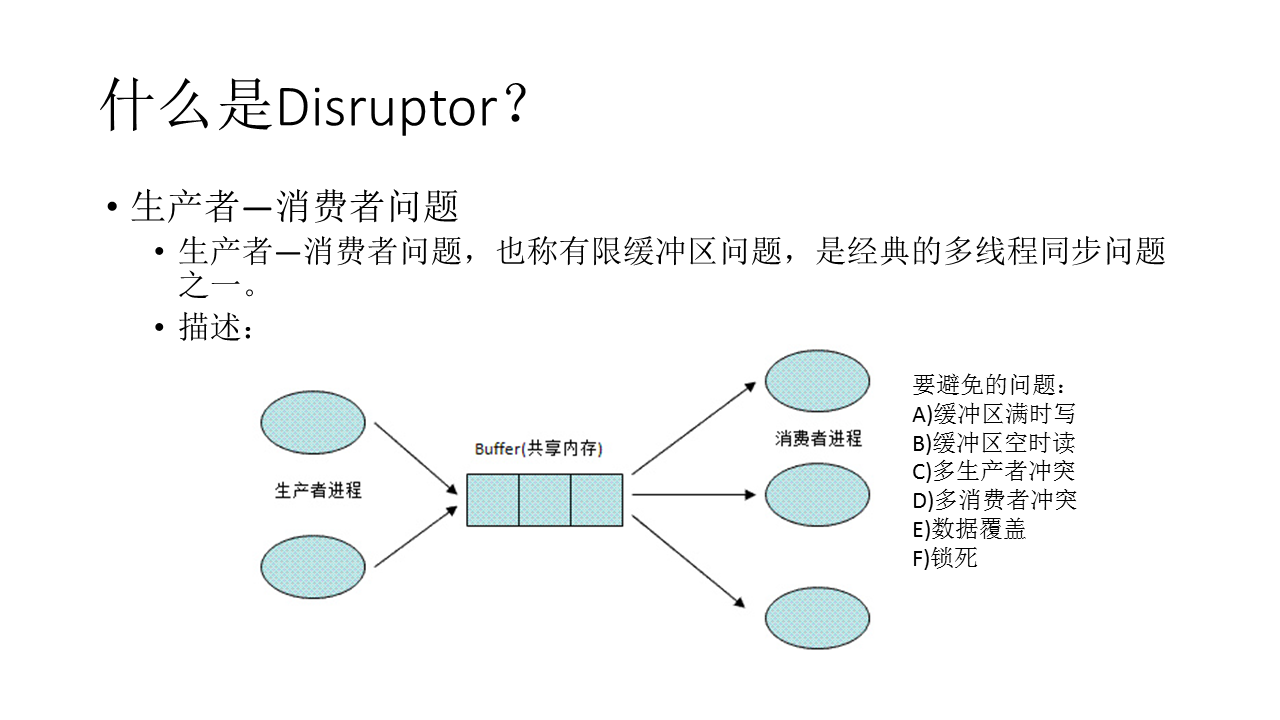
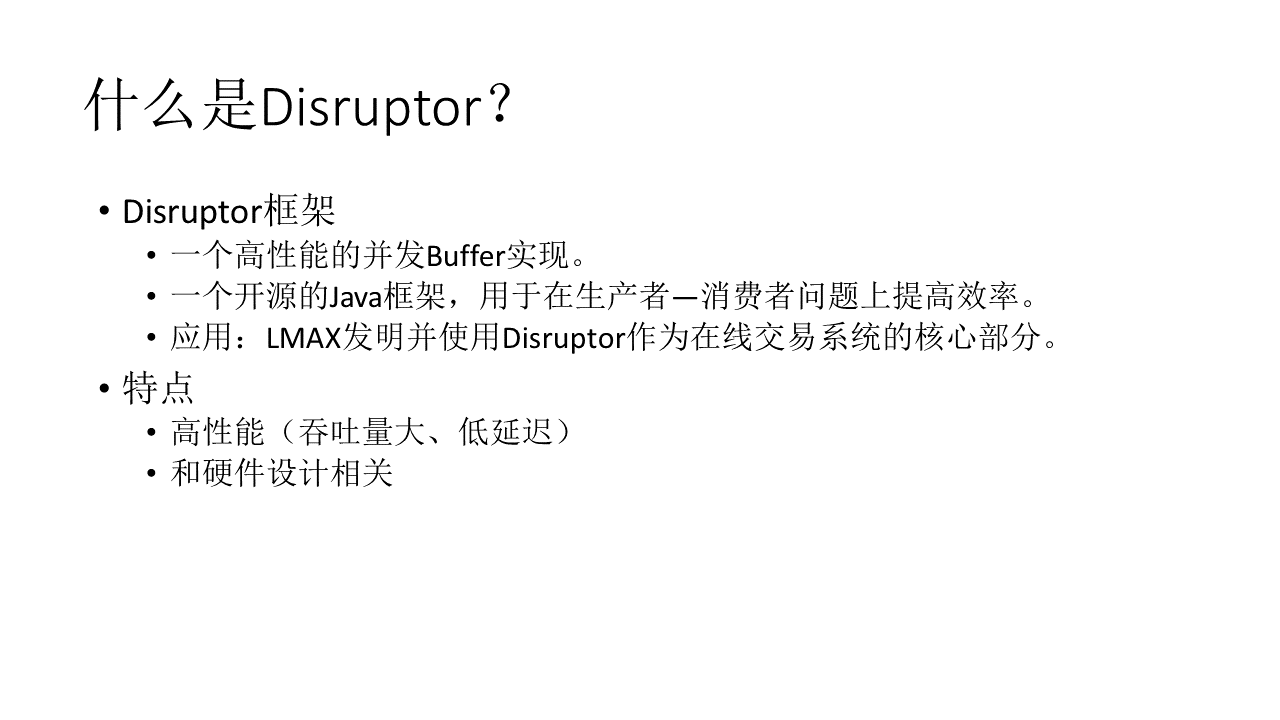
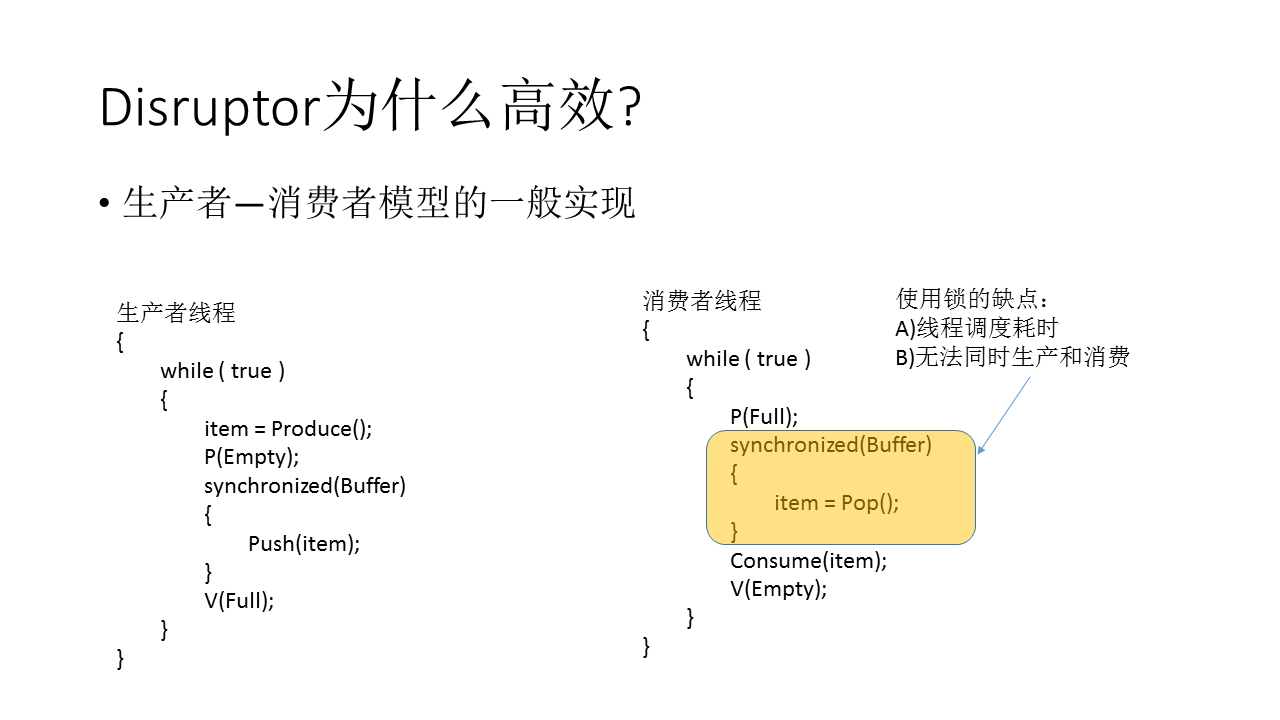
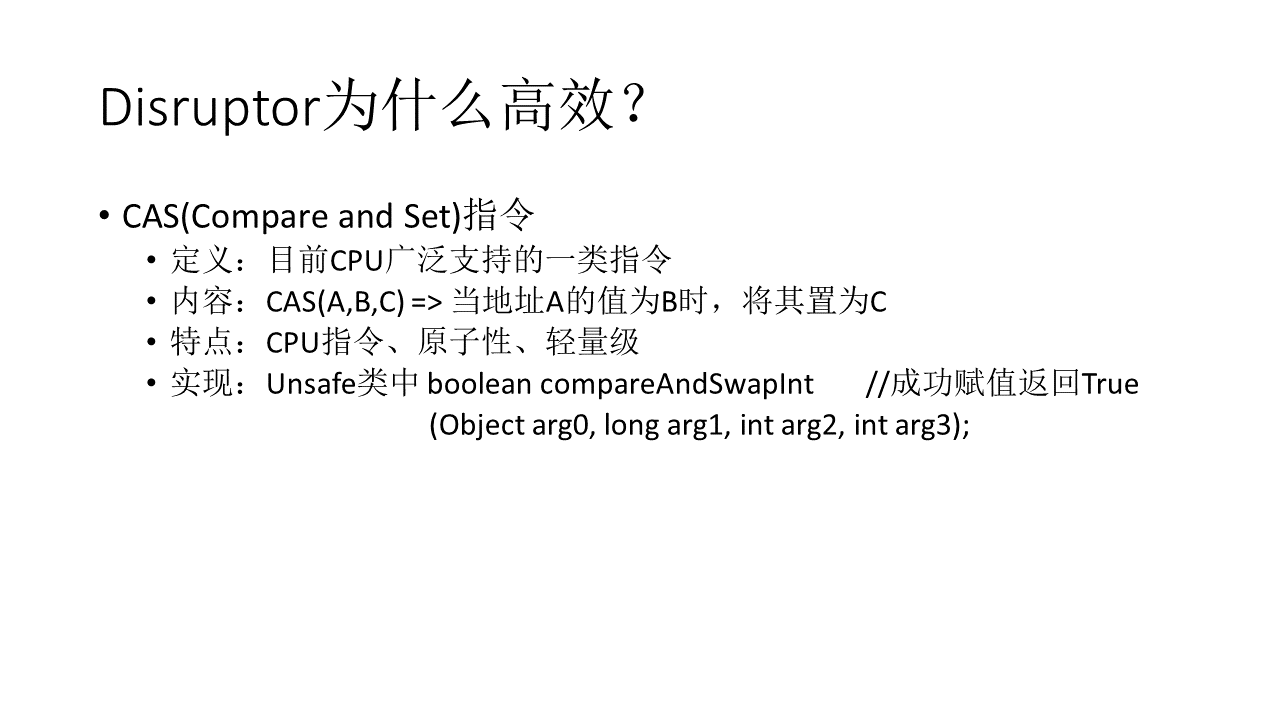
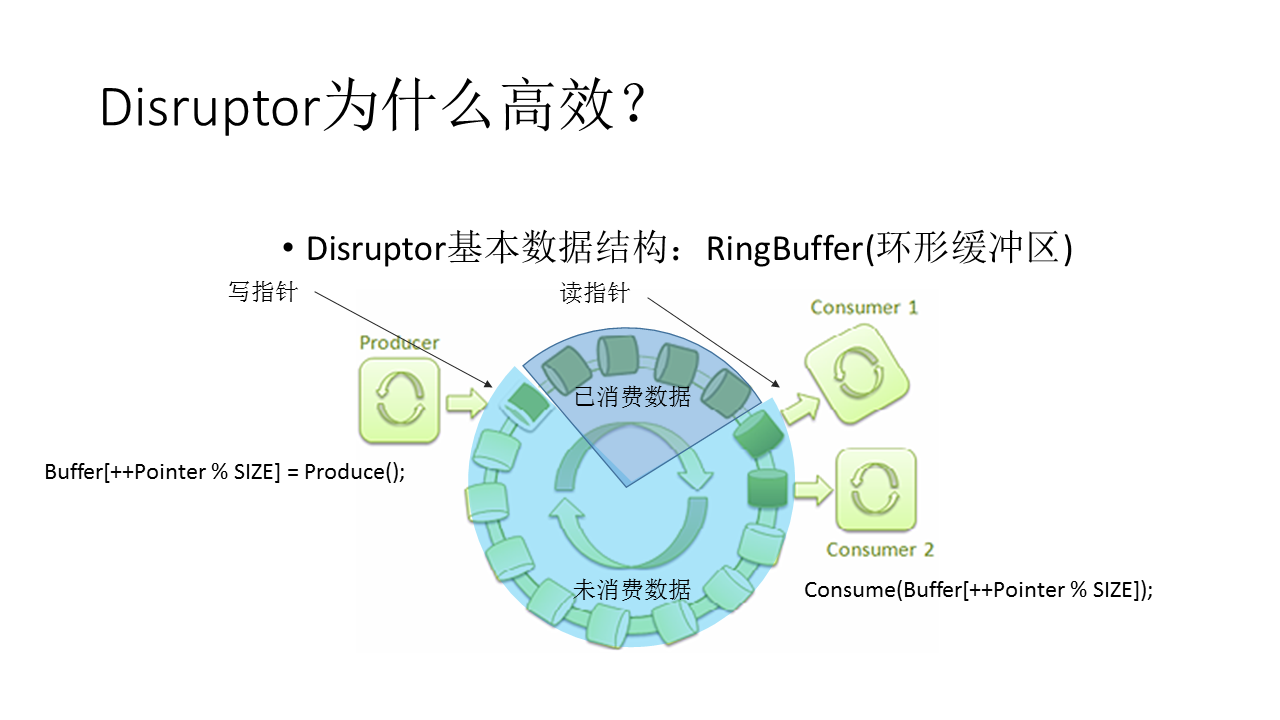
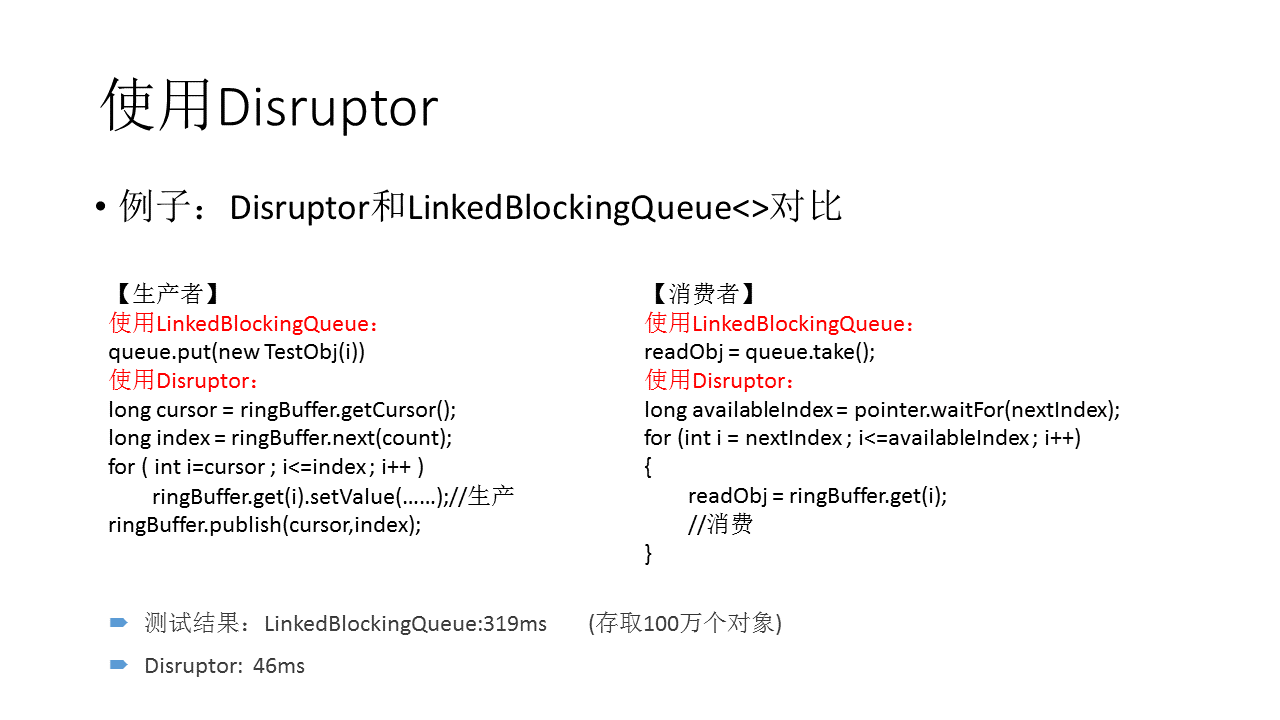
Disruptor
The best way to understand what the Disruptor is, is to compare it to something well understood and quite similar in purpose. In the case of the Disruptor this would be Java's BlockingQueue. Like a queue the purpose of the Disruptor is to move data (e.g. messages or events) between threads within the same process. However there are some key features that the Disruptor provides that distinguish it from a queue. They are:
•Multicast events to consumers, with consumer dependency graph.
•Pre-allocate memory for events.
•Optionally lock-free.
Core Concepts
Before we can understand how the Disruptor works, it is worthwhile defining a number of terms that will be used throughout the documentation and the code. For those with a DDD bent, think of this as the ubiquitous language of the Disruptor domain.
•Ring Buffer: The Ring Buffer is often considered the main aspect of the Disruptor, however from 3.0 onwards the Ring Buffer is only responsible for the storing and updating of the data (Events) that move through the Disruptor. And for some advanced use cases can be completely replaced by the user.
•Sequence: The Disruptor uses Sequences as a means to identify where a particular component is up to. Each consumer (EventProcessor) maintains a Sequence as does the Disruptor itself. The majority of the concurrent code relies on the the movement of these Sequence values, hence the Sequence supports many of the current features of an AtomicLong. In fact the only real difference between the 2 is that the Sequence contains additional functionality to prevent false sharing between Sequences and other values.
•Sequencer: The Sequencer is the real core of the Disruptor. The 2 implementations (single producer, multi producer) of this interface implement all of the concurrent algorithms use for fast, correct passing of data between producers and consumers.
•Sequence Barrier: The Sequence Barrier is produced by the Sequencer and contains references to the main published Sequence from the Sequencer and the Sequences of any dependent consumer. It contains the logic to determine if there are any events available for the consumer to process.
•Wait Strategy: The Wait Strategy determines how a consumer will wait for events to be placed into the Disruptor by a producer. More details are available in the section about being optionally lock-free.
•Event: The unit of data passed from producer to consumer. There is no specific code representation of the Event as it defined entirely by the user.
•EventProcessor: The main event loop for handling events from the Disruptor and has ownership of consumer's Sequence. There is a single representation called BatchEventProcessor that contains an efficient implementation of the event loop and will call back onto a used supplied implementation of the EventHandler interface.
•EventHandler: An interface that is implemented by the user and represents a consumer for the Disruptor.
•Producer: This is the user code that calls the Disruptor to enqueue Events. This concept also has no representation in the code.
Aeron
Aeron is an OSI layer 4 Transport for message-oriented streams. It works over UDP or IPC, and supports both unicast and multicast. The main goal is to provide an efficient and reliable connection with a low and predictable latency. Aeron has Java, C++ and .NET clients.
When to use?
A high and predictable performance is a main advantage of Aeron, it’s most useful in application which requires low-latency, high throughput (e.g. sending large files) or both (akka remoting uses Aeron).
If it can work over UDP, why not to use UDP?
The main goal of Aeron is high performance. That is why it makes sense why it can work over UDP but doesn’t support TCP. But someone can ask what features Aeron provides on top of UDP?
Aeron is OSI Layer 4 (Transport) Services. It supports next features:
1. Connection Oriented Communication
2. Reliability
3. Flow Control
4. Congestion Avoidance/Control
5. Multiplexing
Architecture
Aeron uses unidirectional connections. If you need to send requests and receive responses, you should use two connections.Publisher and Media Driver (see later) are used to send a message, Subscriber and Media Driver — to receive. Client talks to Media Driver via shared memory.
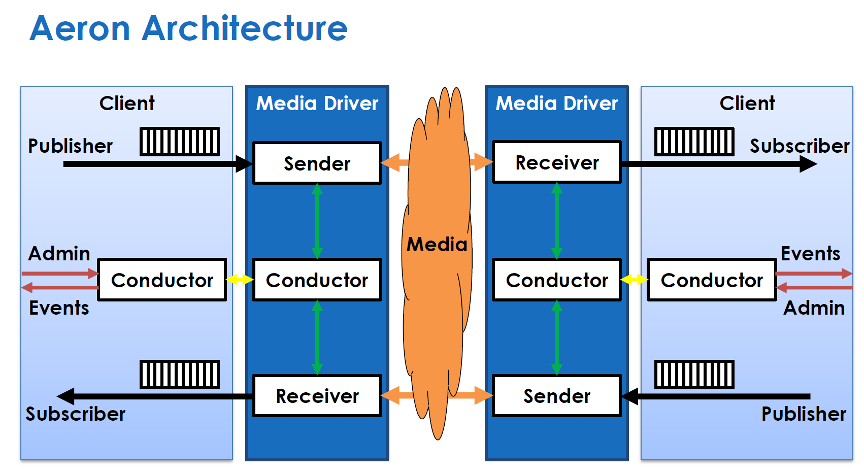
为什么将这两个库在一起聊呢,通常Disruptor框架的核心数据结构circular buffer是Java实现的,主要原因是Java对并发的支持比较友好,而且比较早的支持了内存模型,但是 C++ 11以后,C++ 同样在并发方面有了长足的进步, Aeron就是在这个背景下产生的,虽然核心代码依旧是Java,但是在对C++客户端支持的设计中也实现了比较多的,有价值的数据结构,比如OneToOneRingBuffer, ManyToOneRingBuffer。
下面就以OneToOneRingBuffer为例进行说明,
/* * Copyright 2014-2020 Real Logic Limited. * * Licensed under the Apache License, Version 2.0 (the "License"); * you may not use this file except in compliance with the License. * You may obtain a copy of the License at * * https://www.apache.org/licenses/LICENSE-2.0 * * Unless required by applicable law or agreed to in writing, software * distributed under the License is distributed on an "AS IS" BASIS, * WITHOUT WARRANTIES OR CONDITIONS OF ANY KIND, either express or implied. * See the License for the specific language governing permissions and * limitations under the License. */ #ifndef AERON_RING_BUFFER_ONE_TO_ONE_H #define AERON_RING_BUFFER_ONE_TO_ONE_H #include <climits> #include <functional> #include <algorithm> #include "util/Index.h" #include "util/LangUtil.h" #include "AtomicBuffer.h" #include "Atomic64.h" #include "RingBufferDescriptor.h" #include "RecordDescriptor.h" namespace aeron { namespace concurrent { namespace ringbuffer { class OneToOneRingBuffer { public: explicit OneToOneRingBuffer(concurrent::AtomicBuffer &buffer) : m_buffer(buffer) { m_capacity = buffer.capacity() - RingBufferDescriptor::TRAILER_LENGTH; RingBufferDescriptor::checkCapacity(m_capacity); m_maxMsgLength = m_capacity / 8; m_tailPositionIndex = m_capacity + RingBufferDescriptor::TAIL_POSITION_OFFSET; m_headCachePositionIndex = m_capacity + RingBufferDescriptor::HEAD_CACHE_POSITION_OFFSET; m_headPositionIndex = m_capacity + RingBufferDescriptor::HEAD_POSITION_OFFSET; m_correlationIdCounterIndex = m_capacity + RingBufferDescriptor::CORRELATION_COUNTER_OFFSET; m_consumerHeartbeatIndex = m_capacity + RingBufferDescriptor::CONSUMER_HEARTBEAT_OFFSET; } OneToOneRingBuffer(const OneToOneRingBuffer &) = delete; OneToOneRingBuffer &operator=(const OneToOneRingBuffer &) = delete; inline util::index_t capacity() const { return m_capacity; } bool write(std::int32_t msgTypeId, concurrent::AtomicBuffer &srcBuffer, util::index_t srcIndex, util::index_t length) { RecordDescriptor::checkMsgTypeId(msgTypeId); checkMsgLength(length); const util::index_t recordLength = length + RecordDescriptor::HEADER_LENGTH; const util::index_t requiredCapacity = util::BitUtil::align(recordLength, RecordDescriptor::ALIGNMENT); const util::index_t mask = m_capacity - 1; std::int64_t head = m_buffer.getInt64(m_headCachePositionIndex); std::int64_t tail = m_buffer.getInt64(m_tailPositionIndex); const util::index_t availableCapacity = m_capacity - (util::index_t)(tail - head); if (requiredCapacity > availableCapacity) { head = m_buffer.getInt64Volatile(m_headPositionIndex); if (requiredCapacity > (m_capacity - (util::index_t)(tail - head))) { return false; } m_buffer.putInt64(m_headCachePositionIndex, head); } util::index_t padding = 0; auto recordIndex = static_cast<util::index_t>(tail & mask); const util::index_t toBufferEndLength = m_capacity - recordIndex; if (requiredCapacity > toBufferEndLength) { auto headIndex = static_cast<std::int32_t>(head & mask); if (requiredCapacity > headIndex) { head = m_buffer.getInt64Volatile(m_headPositionIndex); headIndex = static_cast<std::int32_t>(head & mask); if (requiredCapacity > headIndex) { return false; } m_buffer.putInt64Ordered(m_headCachePositionIndex, head); } padding = toBufferEndLength; } if (0 != padding) { m_buffer.putInt64Ordered( recordIndex, RecordDescriptor::makeHeader(padding, RecordDescriptor::PADDING_MSG_TYPE_ID)); recordIndex = 0; } m_buffer.putBytes(RecordDescriptor::encodedMsgOffset(recordIndex), srcBuffer, srcIndex, length); m_buffer.putInt64Ordered(recordIndex, RecordDescriptor::makeHeader(recordLength, msgTypeId)); m_buffer.putInt64Ordered(m_tailPositionIndex, tail + requiredCapacity + padding); return true; } int read(const handler_t &handler, int messageCountLimit) { const std::int64_t head = m_buffer.getInt64(m_headPositionIndex); const auto headIndex = static_cast<std::int32_t>(head & (m_capacity - 1)); const std::int32_t contiguousBlockLength = m_capacity - headIndex; int messagesRead = 0; int bytesRead = 0; auto cleanup = util::InvokeOnScopeExit { [&]() { if (bytesRead != 0) { m_buffer.setMemory(headIndex, bytesRead, 0); m_buffer.putInt64Ordered(m_headPositionIndex, head + bytesRead); } }}; while ((bytesRead < contiguousBlockLength) && (messagesRead < messageCountLimit)) { const std::int32_t recordIndex = headIndex + bytesRead; const std::int64_t header = m_buffer.getInt64Volatile(recordIndex); const std::int32_t recordLength = RecordDescriptor::recordLength(header); if (recordLength <= 0) { break; } bytesRead += util::BitUtil::align(recordLength, RecordDescriptor::ALIGNMENT); const std::int32_t msgTypeId = RecordDescriptor::messageTypeId(header); if (RecordDescriptor::PADDING_MSG_TYPE_ID == msgTypeId) { continue; } ++messagesRead; handler( msgTypeId, m_buffer, RecordDescriptor::encodedMsgOffset(recordIndex), recordLength - RecordDescriptor::HEADER_LENGTH); } return messagesRead; } inline int read(const handler_t &handler) { return read(handler, INT_MAX); } inline util::index_t maxMsgLength() const { return m_maxMsgLength; } inline std::int64_t nextCorrelationId() { return m_buffer.getAndAddInt64(m_correlationIdCounterIndex, 1); } inline void consumerHeartbeatTime(std::int64_t time) { m_buffer.putInt64Ordered(m_consumerHeartbeatIndex, time); } inline std::int64_t consumerHeartbeatTime() const { return m_buffer.getInt64Volatile(m_consumerHeartbeatIndex); } inline std::int64_t producerPosition() const { return m_buffer.getInt64Volatile(m_tailPositionIndex); } inline std::int64_t consumerPosition() const { return m_buffer.getInt64Volatile(m_headPositionIndex); } inline std::int32_t size() const { std::int64_t headBefore; std::int64_t tail; std::int64_t headAfter = m_buffer.getInt64Volatile(m_headPositionIndex); do { headBefore = headAfter; tail = m_buffer.getInt64Volatile(m_tailPositionIndex); headAfter = m_buffer.getInt64Volatile(m_headPositionIndex); } while (headAfter != headBefore); return static_cast<std::int32_t>(tail - headAfter); } bool unblock() { return false; } private: concurrent::AtomicBuffer &m_buffer; util::index_t m_capacity; util::index_t m_maxMsgLength; util::index_t m_headPositionIndex; util::index_t m_headCachePositionIndex; util::index_t m_tailPositionIndex; util::index_t m_correlationIdCounterIndex; util::index_t m_consumerHeartbeatIndex; inline void checkMsgLength(util::index_t length) const { if (length > m_maxMsgLength) { throw util::IllegalArgumentException( "encoded message exceeds maxMsgLength of " + std::to_string(m_maxMsgLength) + " length=" + std::to_string(length), SOURCEINFO); } } }; }}} #endif
使用示例
AtomicBuffer ab(&buff[0], buff.size()); OneToOneRingBuffer ringBuffer(ab); util::index_t tail = 0; util::index_t head = 0; ab.putInt64(HEAD_COUNTER_INDEX, head); ab.putInt64(TAIL_COUNTER_INDEX, tail); std::cout <<"circular buffer capacity is : "<<ringBuffer.capacity() << std::endl;
util::index_t length = 24; util::index_t recordLength = length + RecordDescriptor::HEADER_LENGTH; AtomicBuffer srcAb(&srcBuff[0], srcBuff.size()); srcAb.putInt64(0, 999); srcAb.putStringWithoutLength(8, "0123456789012345"); while (ringBuffer.write(MSG_TYPE, srcAb, 0, length)) { } int timesCalled = 0; const int messagesRead = ringBuffer.read( [&](std::int32_t msgTypeId, concurrent::AtomicBuffer& internalBuf, util::index_t valPosition, util::index_t length) { timesCalled++; std::cout << "circular buffer read value is : " << internalBuf.getInt64(valPosition)
<<" string value: " << internalBuf.getStringWithoutLength(valPosition+8, length - 8) <<" called times: "<< timesCalled <<std::endl; });
运行结果
circular buffer capacity is : 1024 circular buffer read value is : 999 string value: 0123456789012345 called times: 1 circular buffer read value is : 999 string value: 0123456789012345 called times: 2 circular buffer read value is : 999 string value: 0123456789012345 called times: 3 circular buffer read value is : 999 string value: 0123456789012345 called times: 4 circular buffer read value is : 999 string value: 0123456789012345 called times: 5 circular buffer read value is : 999 string value: 0123456789012345 called times: 6 circular buffer read value is : 999 string value: 0123456789012345 called times: 7 circular buffer read value is : 999 string value: 0123456789012345 called times: 8 circular buffer read value is : 999 string value: 0123456789012345 called times: 9 circular buffer read value is : 999 string value: 0123456789012345 called times: 10 circular buffer read value is : 999 string value: 0123456789012345 called times: 11 circular buffer read value is : 999 string value: 0123456789012345 called times: 12 circular buffer read value is : 999 string value: 0123456789012345 called times: 13 circular buffer read value is : 999 string value: 0123456789012345 called times: 14 circular buffer read value is : 999 string value: 0123456789012345 called times: 15 circular buffer read value is : 999 string value: 0123456789012345 called times: 16 circular buffer read value is : 999 string value: 0123456789012345 called times: 17 circular buffer read value is : 999 string value: 0123456789012345 called times: 18 circular buffer read value is : 999 string value: 0123456789012345 called times: 19 circular buffer read value is : 999 string value: 0123456789012345 called times: 20 circular buffer read value is : 999 string value: 0123456789012345 called times: 21 circular buffer read value is : 999 string value: 0123456789012345 called times: 22 circular buffer read value is : 999 string value: 0123456789012345 called times: 23 circular buffer read value is : 999 string value: 0123456789012345 called times: 24 circular buffer read value is : 999 string value: 0123456789012345 called times: 25 circular buffer read value is : 999 string value: 0123456789012345 called times: 26 circular buffer read value is : 999 string value: 0123456789012345 called times: 27 circular buffer read value is : 999 string value: 0123456789012345 called times: 28 circular buffer read value is : 999 string value: 0123456789012345 called times: 29 circular buffer read value is : 999 string value: 0123456789012345 called times: 30 circular buffer read value is : 999 string value: 0123456789012345 called times: 31 circular buffer read value is : 999 string value: 0123456789012345 called times: 32
参考资料
https://github.com/LMAX-Exchange/disruptor
https://github.com/real-logic/aeron
https://medium.com/@pirogov.alexey/aeron-low-latency-transport-protocol-9493f8d504e8
https://github.com/LMAX-Exchange/disruptor/wiki/Getting-Started




 浙公网安备 33010602011771号
浙公网安备 33010602011771号